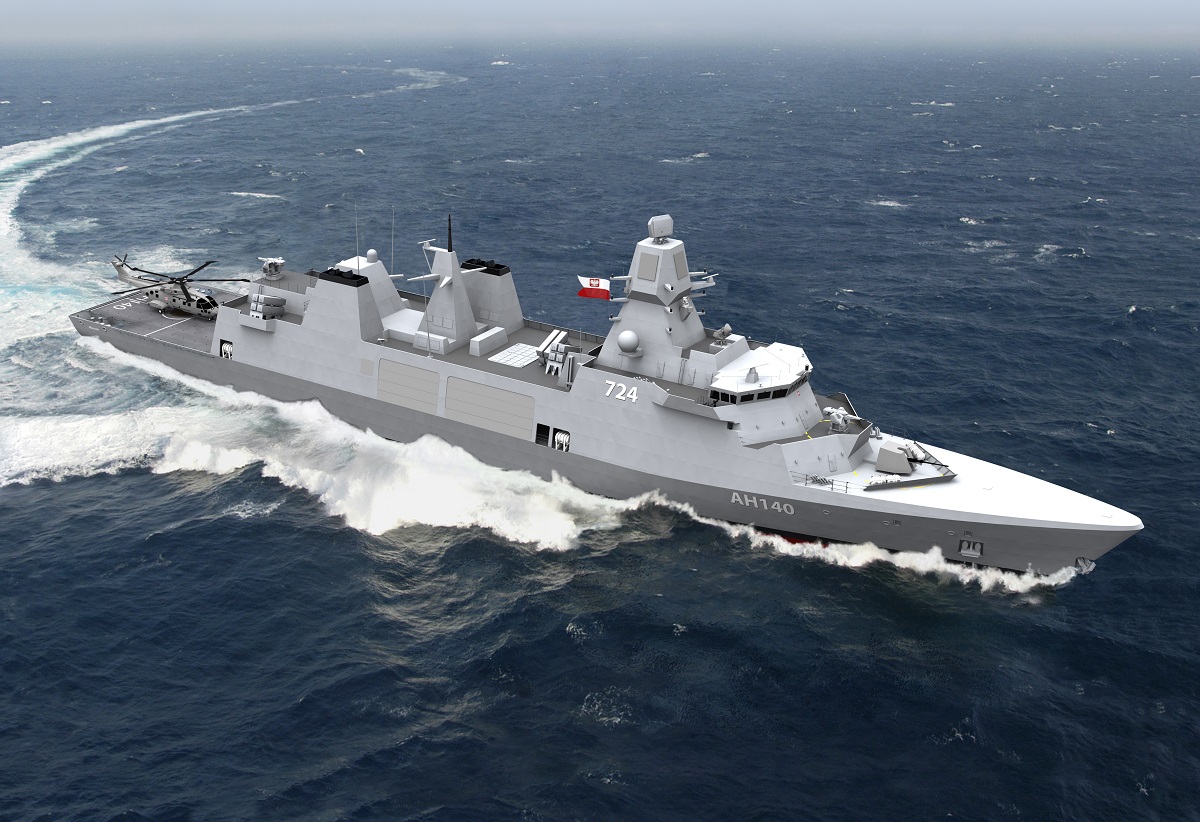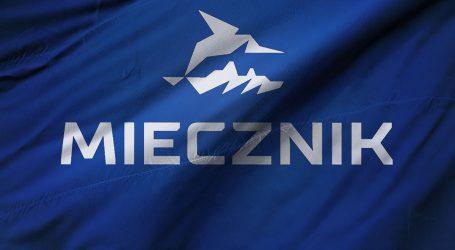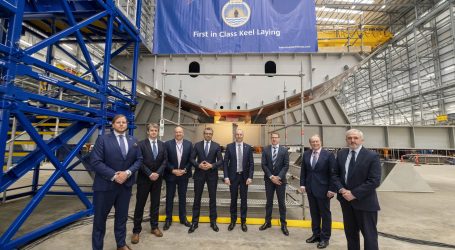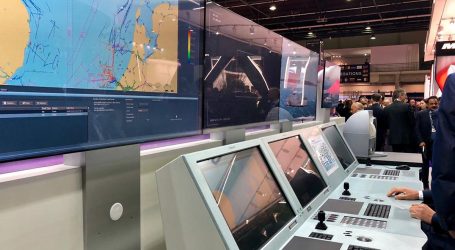On Friday, April 8th, in Gdynia, there was a press briefing concerning the acquisition program of new surface ships of frigate class for the Polish Navy under the cryptonym MIECZNIK (eng. Swordfish). The topic was the ship design and the scope of indispensable infrastructural investments necessary to carry out the project in shipyards PGZ Stocznia Wojenna (Naval Shipyard) and Remontowa Shipbuilding S.A., which are part of the PGZ-MIECZNIK Consortium.
The PGZ-MIECZNIK consortium concluded agreements on strategic cooperation with industrial partners from Great Britain a few days ago.
As a result of the data analysis provided by the PGZ-MIECZNIK Consortium in December 2021, the Polish Armed Forces pre-selected preferred suppliers of platform design and combat systems for new multipurpose ships of the Polish Navy. In negotiations, the PGZ-MIECZNIK Consortium entered into strategic cooperation agreements with the first-choice suppliers – Babcock, Thales UK and MBDA UK.
Babcock will provide the design of the AH140 ship platform and a wide range of knowledge and technology to enable the construction of these craft at the shipyards PGZ Stocznia Wojenna and Remontowa Shipbuilding.
Thales, responsible for the Integrated Combat System (IWS) area, and MBDA, a supplier of air defence systems, will cooperate with PGZ Stocznia Wojenna and OBR CTM S.A. – the latter company has been chosen as the centre of competence for these two foreign partners.
– The Navy, together with the Armament Agency, selected the design as the basis for the AH140 (Arrowhead 140) platform, which was to form the basis for further design to implement all combat systems following the requirements of the ordering party – said Cezary Cierzan, director of the pk. Miecznik, on behalf of the consortium leader PGZ S.A.
The ship’s platform is 138.7m long, 19.7m wide and 5.5m draft, with a maximum displacement of 7,000 tonnes. The ship’s autonomy is expected to be 30 days without replenishment at sea, with a maximum speed of 28 knots and a sailing range of more than 6,000 nautical miles at 18 knots. About 160 people will be able to embark on board, with between 100-120 crew and additional personnel.
The ships will be equipped with the Tacticos Integrated Combat System, MU-90 torpedo system, 76 and 35 mm calibre cannons, CAMM family missile-based air defence system, water-to-water and water-to-ground missile-based RBS family missile system, surveillance and weapons guidance radars, under-keel and towed sonars, and a helicopter hangar.
An interdisciplinary team from all areas of weapon systems worked intensively, especially in the last quarter, where hundreds of hours were spent working together on each area to ensure it was the most cost-effective choice.
Wojciech Nowodziński, responsible for the design process, spoke about the scope of design, the 3D model and the main task in this stage.
– We have done a conceptual design, which the client has accepted, and we are working on that basis. It’s another piece in this puzzle, expanding an existing project. However, we have to remember that these are still preliminary design stages. We must prepare a technical design, working documentation and several others based on market needs. There is an ambitious schedule, needs and opportunities. We are starting the 3D model work very early to represent the ship as much as possible and discuss the next steps, including all the partners and the client. Everyone can see what we’re doing early in the design stage, make comments, and help the process.
The 3D model will be very detailed. Apart from the fact that it will contain all the standard elements, the ship’s electrics will also be precisely defined.
“Being aware that a ship of this class contains a huge number of cables, connections and signals, we decided in the initial stages of the project to model all the wiring ducts with details. As a result, we will be able to identify each cabling element on this ship,” added Wojciech Nowodziński.
Paweł Lulewicz, the PGZ Naval Shipyard CEO and Marcin Ryngwelski, the CEO of Remontowa Shipbuilding, spoke about how the shipyards, part of the Consortium, prepared for the task.
– As far as infrastructure investments are concerned, we are on the eve of announcing a tender to choose a design office that will design our initial assumptions. We are talking about the hall for assembling the ship’s hull, which will be built largely by our partner, Remontowa Shipbuilding S.A. – said the CEO of PGZ Naval Shipyard.
In turn, Ryngwelski stressed that the frigate would be built in the formula of Development Work. The allocation of work within the Consortium will be determined at the Preliminary Design stage.
– The ship’s equipment and systems integration will be at the PGZ Naval Shipyard premises. However, if there is a need, we are ready to build the whole platform in our shipyard – added Marcin Ryngwelski. – Our goal is to support the colleagues from PGZ S.A., the Consortium leader. Still, we are also willing to share our experience in managing a large military program such as “Kormoran” or “Tugboat” (the latter two are completed or underway by Remontowa Shipbuilding acting as a leader).
The CEO of Remontowa Shipbuilding added that many modernization works would take place in this shipyard to adapt its infrastructure to the programme’s requirements.
– This includes roofing one of the assembly plate tracks to make us independent from weather conditions and improve our employees’ work comfort. We must also prepare a professional hall to paint and maintain large steel structures. We also need to change the shipyard’s I.T. system and implement an ERP; to buy modern machinery and equipment, e.g. a complete line for flat sections, allowing the hull production process to be automated.
As Ryngwelski pointed out, support from the official side would also be necessary. Relevant permits for construction works are needed to be obtained faster than usually. The infrastructure investment programme in the Remontowa Shipbuilding S.A. shipyard will start in the second quarter of 2022.
The MIECZNIK programme involves the acquisition of three modern frigates for the Polish Navy. Multipurpose vessels of this class will increase the fleet’s capabilities and allow the implementation of a wide range of tasks at sea, including the protection of shipping routes and critical infrastructure. Moreover, the ships will increase the combat potential of the Polish Armed Forces. Still, they will also constitute a significant contribution of the Republic of Poland within the North Atlantic Alliance, e.g. by performing tasks within the NATO Standing Groups of Ships framework.
According to the schedule, by March next year, a Preliminary Design will be developed with the Integrated Combat System, and updates to the technical and economic analyses will be carried out, including management plans, programme schedules and cost estimates, as well as work on the 3D model. In addition, this phase will complete, among other things, the procurement of equipment such as the main propulsion for the construction of all three craft.
Construction of the first ship, training and trials are planned for 2026/2028.
source: PortalMorski.pl




